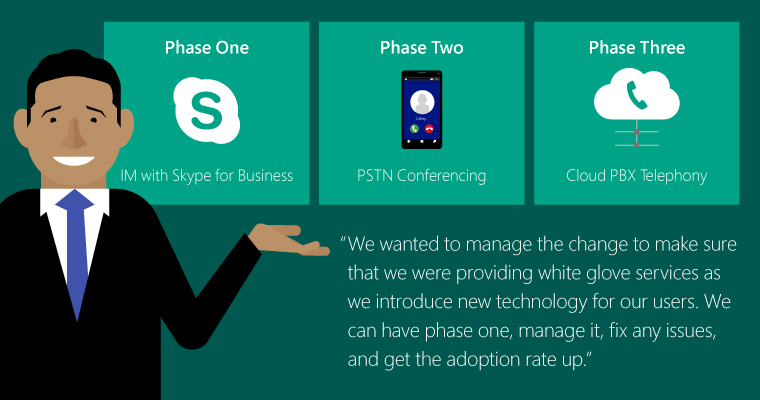
How Argo Turboserve modernized their telephony system with Skype
| Focus on: Empower Employees, Optimize Operations |
A world-class supply chain management services company, Argo Turboserve (ATC) seeks to improve the bottom-line results of their customers through advanced analytics and custom tools. With their own global expansion and the evolving complexities of their customers in the nuclear, aerospace, industrial supply chain, and distribution and services industries, ATC team members like Bilal Khan constantly explore new opportunities for innovation and development. Bilal is the Global Security and Network Manager at ATC, where he’s spent the last five years managing their telecommunication and security solutions. During that time, Bilal treated the legacy PBX (public branch exchange) systems across all twenty-five of ATC’s worldwide locations, twenty-five independent telephony systems that were constantly failing and creating a great rift between ATC employees and their customers.
“We had legacy ad hoc PBX [systems] at every location with no management, end of life, and no support from vendors,” Bilal explains. “We started seeing the cost of telecommunication increase exponentially. We used to spend $7,800 a month in conferencing alone.”

Bilal’s goal was to not only unite ATC’s disparate PBX systems, but usher their voice solutions into the digital age with a modern cloud PBX system with high availability, business continuity, and disaster recovery tools. With that in mind, Skype for Business was the natural decision for scalability, unification, and meeting ATC’s specific interests. By choosing Skype for Business, Bilal and his team found a cloud voice solution that integrated into their existing infrastructure and further leveraged their previous Office 365 investment, meaning ATC employees and customers received an exciting new PBX solution that wouldn’t overwhelm their users.
Three phases of executionTo better manage their adoption, ATC took a three-phase approach to implementation:
Phase One: IM with Skype for Business
Phase Two: PSTN Conferencing
Phase Three: Cloud PBX Telephony
By starting the onboarding process with instant messaging, Bilal could introduce the ATC team to the Skype for Business platform through a familiar process with a simple learning curve.
“We wanted to manage the change,” Bilal explains, “to make sure that we were providing white glove services as we introduce new technology for our users. We can have phase one, manage it, fix any issues, and get the adoption rate up.”
While incredibly useful, IM offers a low-stakes tech tool that can be explored, adjusted, and applied as Bilal’s coworkers became more and more comfortable with the solution.
Phase Two replaced ATC’s previous audio-only conferencing tools with HD video equipped PSTN Conferencing. This not only replaced an outdated solution, but introduced screen sharing capabilities, increased collaboration tools, and added mobility solutions to the ATC telecommunication experience.

Finally, Phase Three replaced ATC’s entire onsite telecomm infrastructure with Cloud PBX. Initial concerns about cloud dialing were quickly resolved when users realized they could keep their established phone numbers and traditional communication resources.
Bilal says, “There’s no extensions anymore. You call people; you don’t call numbers.”
Empowered employees through flexibilityToday, ATC’s Cloud PBX adoption equips Bilal and his coworkers with not just a modern voice solution, but the tools to work from home as they deem necessary. The flexibility to jump from desktop to mobile device or call in to meetings from a home office or hotel room means fewer employees have to commute into New York City or brave inclement weather, to the extent that Bilal’s office is mostly a meeting point these days.
That mobility isn’t limited to just Greater New York, with Skype for Business driving their new PBX tools, ATC employees have seen a spike in global mobility. Without VPN requirements tethering it to a single server, Skype for Business allows ATC users to jump in and out of meetings and conversations from any of their twenty-five locations and beyond. That freedom lets team members make and receive calls from the Skype for Business app from a litany of devices, including laptops, tablets, and smart phones—an added opportunity for the ATC team to work at home, in the office, or anywhere else they find, without creating security risks or interrupting business continuity.

That added flexibility allows Bilal and his team the added benefit of scalability. Now, ATC can onboard new employees in minutes instead of days, and can continue to adapt their SLA base on their needs and the needs of their customers. This new level of efficiency has driven a great level of savings across ATC, including an annual $180,000 from their PSTN Conferencing adoption.
“By having everything in the cloud we moved away from on-premise and worrying about patching and servicing and hardware and moved to operating expense,” says Lookman Fazal, ATC CTO. “We got out of the business of managing PBX and now we can focus on innovation.”
With this revolutionized cloud PBX system, ATC has improved their customer communication and collaboration processes. Today, team members can share their screens with onsite partners, set up ad hoc meetings to respond to urgent customer requests, or resolve issues quickly with a simple instant message. These, plus the added stability and mobile access, have helped ATC improve their customer satisfaction ratings and shape the organization to continue their mission today and into the future.
Related Content
- Find more Real Stories of Digital Transformation
- Join this webcast to learn how to expand communication possibilities beyond meetings
- Discover seamless collaborating in meetings! Register for the webcast.





